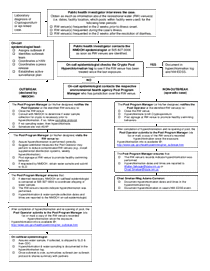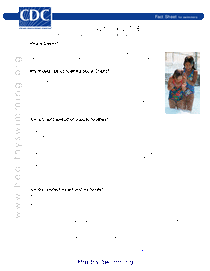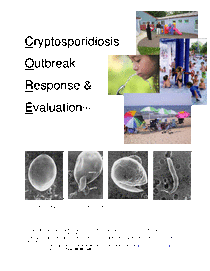Recreational Water Illness
Publications
 Cryptosporidium Investigation Flowchart Algorithm
Water Illness - General
May 20, 2010
Cryptosporidium Investigation Flowchart Algorithm
Water Illness - General
May 20, 2010
This document contains a flowchart that illustrates the steps that should be taken during a Cryptosporidium investigation.
 Diarrhea Pool Posters
Water Illness - Marketing
May 12, 2009
Diarrhea Pool Posters
Water Illness - Marketing
May 12, 2009
This document contains Two different 8.5 x 11 posters in both English and Spanish, a total of 4 posters to print and display at public pools.
 Healthy Swimming Brochure
Water Illness - Marketing
May 12, 2009
Healthy Swimming Brochure
Water Illness - Marketing
May 12, 2009
This brochure was created by the CDC and explains how to protect yourself and your family against Recreational Water Illness. It provides three simple steps for water safety, reminds people that they share pool water with everyone and that it is not drinking water, has separate sections inside for swimmers and parents, and even provides details about crypto, E. coli, and how diarrheal illness spreads.
 Water Sample Collection Protocol
Water Illness - General
May 11, 2009
Water Sample Collection Protocol
Water Illness - General
May 11, 2009
Water samples can be tested for pathogens such as Cryptosporidium. These samples can then potentially be linked to clinical isolates from individuals who visited a recreational water venue associated with cluster of cases. Collecting a sample of the backwash from a pool filter is ideal because it increases the chances of detecting the parasite if it was present during the previous filter run.
 Hyperchlorination to Kill Cryptosporidium
Water Illness - General
May 11, 2009
Hyperchlorination to Kill Cryptosporidium
Water Illness - General
May 11, 2009
Cryptosporidium (or “Crypto”) is a chlorine resistant parasite, so even well-maintained pools, water parks, and interactive fountains can spread Crypto among swimmers. If an outbreak of Crypto infections occurs in your community, the health department might ask you to hyperchlorinate.
 Cryptosporidiosis in Childcare Settings
Water Illness - General
May 11, 2009
Cryptosporidiosis in Childcare Settings
Water Illness - General
May 11, 2009
Cryptosporidiosis is a gastrointestinal illness, caused by the parasite, Cryptosporidium. This disease is a common cause of diarrhea in children, especially in child care settings. The hallmark symptom of cryptosporidiosis is watery diarrhea, which might be accompanied by stomach ache, nausea and vomiting, fever, and a general sick feeling.
 Cryptosporidium Quiz for Swimmers
Water Illness - Help
May 11, 2009
Cryptosporidium Quiz for Swimmers
Water Illness - Help
May 11, 2009
This short single page (double-sided) quiz asks a series of true/false questions and provides answers on the back. It covers topics such as whether or not chlorine kills cryptosporidium quickly, the effect of swallowing pool water that has crypto in it, practical ways to keep you and the pool safe, and much more.
 Cryptosporidium Fact Sheet
Water Illness - Help
May 11, 2009
Cryptosporidium Fact Sheet
Water Illness - Help
May 11, 2009
This fact sheet is available in both English and Spanish. It explains what Cryptosporidium is, why you should be concerned about it, how it is spread, and how to protect yourself and your family.
 Cryptosporidium Outbreak Response Guidelines
Water Illness - Guide
May 11, 2009
Cryptosporidium Outbreak Response Guidelines
Water Illness - Guide
May 11, 2009
Outbreak and case reporting data for cryptosporidiosis document increases in transmission of the parasite, Cryptosporidium, over the last 2 decades. This is in part due to the parasite’s low infectious dose, potential for zoonotic transmission, presence in the natural environment, small size that challenges water filtration systems, and its high resistance to chlorine disinfection.
 Cryptosporidium Fact Sheet for Pool Operators
Water Illness - Help
May 11, 2009
Cryptosporidium Fact Sheet for Pool Operators
Water Illness - Help
May 11, 2009
Cryptosporidiosis is a diarrheal disease caused by microscopic parasites, Cryptosporidium, that can live in the intestine of humans and animals and is passed in the stool of an infected person or animal. Both the disease and the parasite are commonly known as "Crypto." The parasite is protected by an outer shell that allows it to survive outside the body for long periods of time and makes it very resistant to chlorine-based disinfectants.
 Healthy Swimming Presentation
Water Illness - Presentation
May 11, 2009
Healthy Swimming Presentation
Water Illness - Presentation
May 11, 2009
This presentation was created by the CDC and covers a wide range of topics including what recreational water illness is, diarrheal illness, fecal contamination of recreational water, and pool operation and maintenance. It also provides a number of supporting data graphs and charts.

